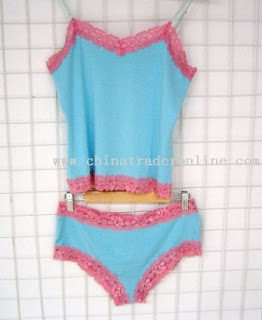Lingerie may also refer to undergarments incorporating flexible, stretchy, sheer, or decorative materials like Lycra, nylon (nylon tricot), polyester, satin, lace, silk and sheer fabric. However, certain cotton or synthetic undergarments can also be considered to be lingerie.
The term in the French language applies to all undergarments for either gender. In English it is applied specifically to those undergarments designed to be visually appealing or erotic.
Origins
The concept of lingerie as a visually appealing undergarment was developed during the late nineteenth century. Lady Duff-Gordon of Lucile was a pioneer in developing lingerie that freed women from more restrictive corsets. Through the first half of the 20th century, women wore underwear for three primary reasons: to alter their outward shape (first with corsets and later with girdles or bras), for hygienic reasons, or for modesty. Before the invention of crinoline, women's underwear was often very large and bulky. During the late 19th century, corsets became smaller, less bulky and constricting, and were gradually supplanted by the brassiere, first patented in the 20th century by Mary Phelps Jacob. When the First World War broke out, women found themselves filling in men's work roles, creating a demand for more practical undergarments. Manufacturers began to use lighter and more breathable fabrics.As the 20th century progressed, underwear became smaller and more form fitting. In the 1960s, lingerie manufacturers such as Frederick's of Hollywood begin to glamorize lingerie. The lingerie industry expanded in the 21st century with designs that doubled as outerwear. The French refer to this as 'dessous-dessus' which basically means innerwear as outerwear.
Market structure
The lingerie market at the turn of 21st century was driven by the advent of modern technologies and fabrics that help in designing innovative products such as laser-cut seamless bras and moulded T-shirt bras. Designers are putting greater emphasis on rich-looking fabrics, laces, embroideries and brighter, more daring colors.The global lingerie market in 2003 was estimated at $29 billion, while in 2005, Bras accounted for 56 per cent of the lingerie market and briefs represented 29 per cent. The world’s largest lingerie retailer, Victoria's Secret, operates almost exclusively in North America, but the European market is fragmented, with Triumph International and DB Apparel predominant.
The largest online retailer of men's underwear and a leading online retailer of women's intimates, Freshpair is located in New York City, with its warehouse in Texas.
Since the mid-1990s, women have had more choice in bra sizes; the focus has changed from choosing bras in an average size to wearing bras that actually fit perfectly. In the UK, for instance, the media is fuelling an awareness campaign about the need for each woman to have a proper bra fitting before every purchase.
Undergarment
"Underwear" redirects here. For other uses, see Underwear (disambiguation).
Undergarments or underwear are clothes worn under other clothes, often next to the
skin. They keep outer garments from being soiled by bodily secretions and
discharges, shape the body, and provide support for parts of it. In cold
weather, long
underwear is sometimes worn to provide additional warmth. Some undergarments
are intended for erotic effect.
Special types of undergarments have religious significance. Some items of
clothing are designed as underwear, while others, such as T-shirts and certain types of shorts, are appropriate
both as undergarments and as outer clothing. If made of suitable material, some
undergarments can serve as nightwear or swimsuits.Undergarments are generally of two types, those that are worn to cover the torso and those that are worn below the waist, though garments which cover both also are available. Different styles of undergarments are generally worn by women and men. Undergarments commonly worn by women today include brassieres and panties (known in the United Kingdom as knickers), while men often wear briefs or boxers. Items commonly worn by both sexes include T-shirts, sleeveless shirts (also called singlets or tank tops), bikini underwear, thongs, and G-strings.



























No comments:
Post a Comment